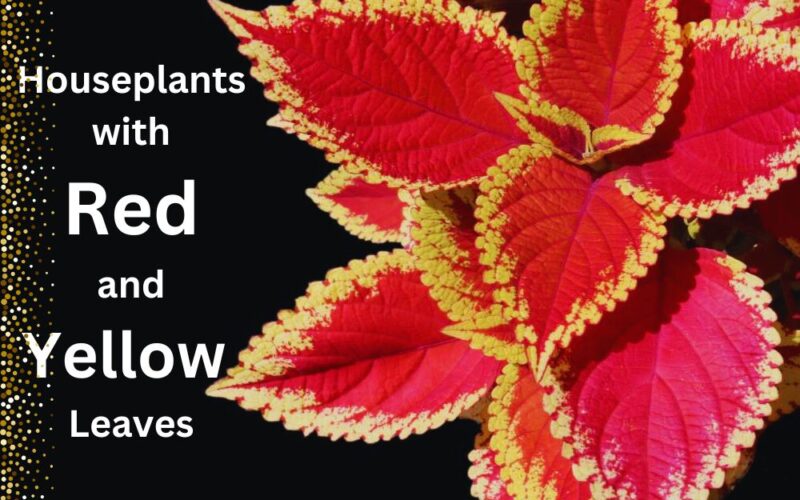In this article, I will talk with you about red and yellow houseplants, a burst of color in your indoor space. Here, you will find a list of indoor plants with red and yellow leaves. However, there are several house plants with red and yellow flowers which we discuss in another article.
Adding Vibrancy to Your Living Space; houseplants with red and yellow leaves are the perfect choice for those who want to add a touch of the beauty of nature to their home. Hence, if you keep reading, you will first find a list of the red and yellow leave indoor plants and after that, I will provide you with pro tips for caring for them to ensure their flourishing growth.
if you are ready, let’s get going to bring vibrant hues to your house that will uplift the ambiance.
Red and Yellow Houseplants: Exploring the Beauty
Houseplants with red and yellow leaves are a fantastic way to introduce bold and eye-catching shades into your living environment. Taking care of red and yellow leaves plants is essential to maintain their vibrant colors and overall health.
These plants require specific care considerations to thrive indoors. By understanding the specific needs of croton, coleus, and caladium plants, you can ensure their vibrant foliage continues to adorn your indoor space.
Let’s delve into some popular varieties that will undoubtedly steal the show:
Red and Yellow Varieties of Croton Plants
Croton plants are renowned for their striking foliage, featuring a mesmerizing blend of red, yellow, orange, and even purple hues. Here are some captivating varieties to consider:
Petra Croton
The Petra Croton boasts large, glossy leaves splashed with vibrant red, orange, and yellow colors. Its leaves are typically long and pointed, creating an elegant look that can become a focal point in any room.
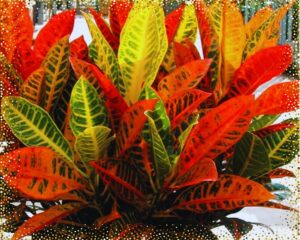
Mammy Croton
With its unique elongated leaves showcasing a mix of deep red and bright yellow, the Mammy Croton is a true masterpiece. Its multicolored foliage adds an artistic touch to your indoor space.
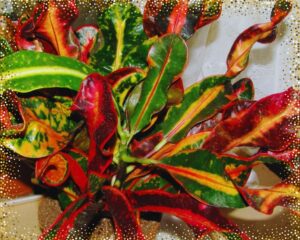
Icetone Croton
The Icetone Croton features leaves with a distinctive ice-like appearance, combining shades of red, yellow, and green. This variety brings a refreshing and invigorating feel to your home.
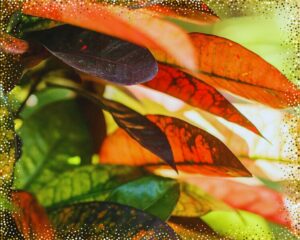
Caring Points for Croton Plants
Croton plants are known for their vivid foliage and intricate color patterns. To ensure their well-being, keep these caring tips in mind:
| Lighting: | Croton plants thrive in bright, indirect light. Place them near windows with filtered sunlight. Insufficient light can cause the colors to fade. |
| Watering: | Keep the soil consistently moist, but avoid waterlogging. Allow the top inch of soil to dry between watering sessions. |
| Humidity: | Crotons prefer higher humidity levels. Mist the leaves regularly or use a humidity tray to maintain adequate moisture. |
| Temperature: | Maintain a warm environment with temperatures above 60°F (15°C). Protect them from cold drafts and sudden temperature drops. |
Red and Yellow Varieties of Coleus Plants
Coleus plants are known for their intricate leaves, which can feature a wide spectrum of colors. Here are a couple of captivating options:
Red Coleus plant yellow edge
The Red Coleus boasts deeply serrated leaves with a mix of red and yellow. Its textured foliage adds depth and dimension to your indoor garden.

Coleus Blumei Rainbow Mix
With leaves resembling a painter’s palette, the Rainbow Blumei Coleus offers a vivid display of red, green, yellow, and orange hues. Its leaves are a true work of art.
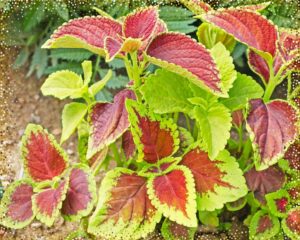
Caring Points for Coleus Plants
Coleus plants are prized for their diverse leaf colors and patterns. To keep them thriving, follow these care guidelines:
| Lighting: | Coleus plants thrive in partial to full shade. Avoid direct sunlight, as it can fade their vibrant colors. |
| Watering: | Keep the soil consistently moist but not waterlogged. Adjust watering frequency based on the environmental conditions. |
| Pinching and Pruning | Pinch the tips of growing stems to encourage bushier growth and prevent leggy appearance. Prune regularly to maintain a neat shape. |
| Soil Choice: | Use well-draining soil enriched with organic matter. Good drainage prevents waterlogged roots. |
Red and Yellow Varieties of Caladium Plants
Caladium plants showcase heart-shaped leaves that come in a variety of captivating color combinations. Here are some standout options:
Caladium ‘Yellow Blossom’
This variety features large leaves with a red center and yellow edges. The combination of colors creates a soft and elegant appearance, perfect for adding a touch of sophistication to your decor.
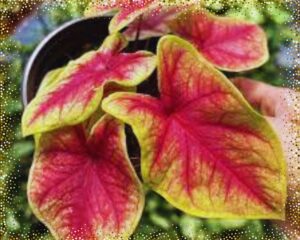
Caladium bicolor ‘New Wave’
vibrant red to orange leaves with deep yellow veins and borders, it will Caladium adds drama and flair to your indoor garden. Its contrasting colors make for an eye-catching sight.
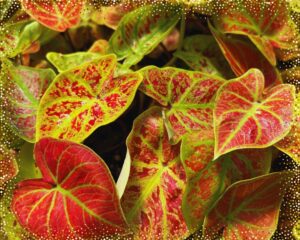
Caladium Orange (Hydroculture)
it has vibrant yellow leaves with a splash of red to orange on them. It will add more lights to your dim room.
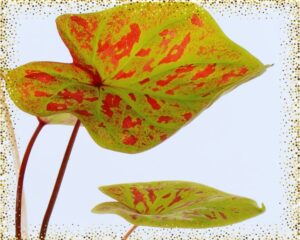
Caring Points for Caladium Plants
Caladiums showcase heart-shaped leaves and thrive in warm, tropical conditions. Here’s how to care for them:
| Light and Shade | Caladiums prefer indirect light or filtered sunlight. Avoid direct sun, as it can scorch their delicate leaves. |
| Soil Moisture: | Keep the soil consistently moist, but not soggy. Mist the leaves to provide additional humidity, especially in drier environments. |
| wintering: | In cooler months, when growth slows down, reduce watering and allow the soil to dry out slightly between waterings. |
| Dormancy Period: | Caladiums may go dormant during winter. If leaves die back, stop watering and store the bulbs in a cool, dry place. |
Conclusion
Here, you found a list of house plants with red and yellow leaves belonging to crotons, coleus, and caladium plants. In addition, I told you a lot of pro tips for caring for them. now you can Incorporate them into your indoor space and bring nature’s vibrancy to your living space.
Can you add other red and yellow leaves to our list? Do you think with ones are perfect for your indoor decoration? Why? Please tell us about your ideas below this page. In the following, I provide you with some of the most asked questions, please read them and if you have any other problems with growing these beautiful plants, ask me. I will answer them as soon as possible.
FAQs About Houseplants with Red and Yellow Leaves
Are red and yellow houseplants suitable for low-light environments?
While they prefer bright, indirect light, there are some varieties that can tolerate lower light conditions. Consider varieties like Petra Croton or Red Ruffles Coleus.
How often should I fertilize my red and yellow houseplants?
Fertilize every 4-6 weeks during the growing season (spring and summer) with a balanced liquid fertilizer diluted to half strength.
Can I keep red and yellow houseplants outdoors?
These plants are primarily indoor plants. However, some varieties can be placed on patios or balconies as long as they’re shielded from direct sunlight.
What should I do if the leaves start losing their vibrant colors?
Dull colors could be due to insufficient light or poor nutrition. Adjust the lighting and consider fertilizing to enhance leaf color.
Do red and yellow houseplants require high humidity?
Yes, many of these plants prefer higher humidity levels. You can mist them regularly or place a humidity tray nearby.
Is it normal for red and yellow houseplants to lose leaves in winter?
Yes, some leaf loss is natural during the dormant period. Keep watering and care consistent but reduce fertilization.
Can I mix different varieties of red and yellow houseplants in the same pot?
It’s possible, but be mindful of their individual care requirements. Ensure they share similar lighting and water preferences.
How do I prevent pests from infesting my red and yellow houseplants?
Regularly inspect your plants for pests like aphids or spider mites. If detected, isolate the plant and treat it with insecticidal soap or neem oil.

Elahe Rabiei
Hi, I’m Elaheh. My Academic major is plant protection, and houseplants are my expertise. As a houseplant lover, my house is full of indoor plants and it is my passion to take care of them. Hence, I’m here to share my knowledge and experience about growing healthy houseplants. I am also a plant protection advisor, so feel free to ask me any questions you may have.

